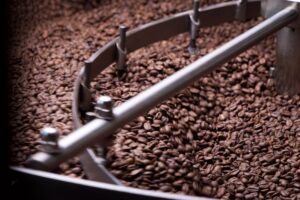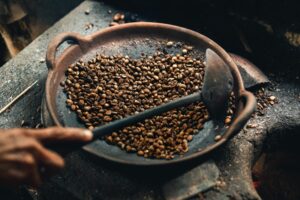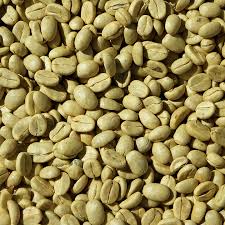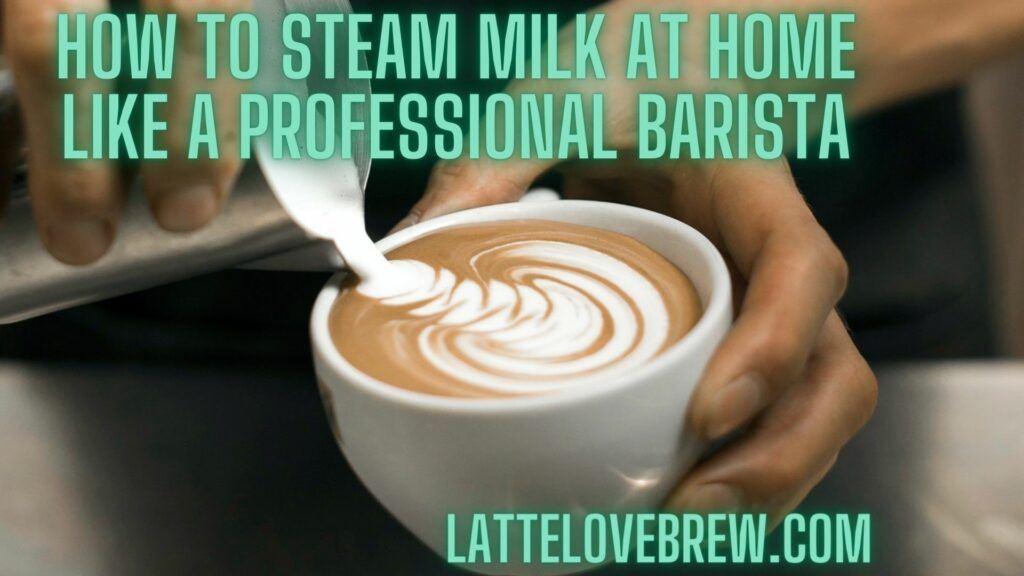Last updated on May 28th, 2024 at 10:41
Espresso roasting does not need to be complicated or complex. Coffee roasting is something that is actually very easy and there is nothing difficult about it. It takes patience and practice.
You need the right green coffee beans, the right home roasting equipment. If you are new to the home roasting revolution, I strongly advise you to roast your beans in very small quantities and get into the practice.
Espresso roasting and coffee roasting in general opens up a whole new coffee world for you where you can get down and really alter and perfect how your coffee tastes by mixing and matching single origin beans and even omni roasting – using different roasting profiles within a single coffee that you are brewing.
Keep reading as I dig down and detail the aspects of roasting for a perfect espresso shot.
What Is The Best Roast For Espresso?
Table Of Contents
- 1 What Is The Best Roast For Espresso?
- 2 What Is Espresso?
- 3 Why Roast For Espresso?
- 4 How To Roast For A Perfect Espresso Shot
- 5 Roasting For Milk Based Espresso Drinks (Lattes, Flat Whites, Cappuccinos, Mochas, Cortados etc)
- 6 Choosing What Green Coffee Beans To Roast
- 7 What Is A Good Espresso Roast?
- 8 Espresso Roasting Temperature
- 9 Frequently Asked Questions About Espresso Roasting
- 9.1 What Is Special About An Espresso Roast?
- 9.2 What Roasts Are Best For Espresso?
- 9.3 Is Espresso A Roast Or A Grind?
- 9.4 Is Light Roast Good For Espresso?
- 9.5 How Long To Roast For Espresso?
- 9.6 What Temperature Is Espresso Roasted At?
- 9.7 Is Espresso Roast The Strongest?
- 9.8 Can You Roast Your Own Espresso Beans?
- 10 Frappé-Ing It All Up – Espresso Roasting
There is a fair bit of controversy around which roast is best for an espresso. Many coffee connoisseurs and coffee lovers will insist that a dark roast is best for a great tasting, deep and dark shot of espresso. Often you will see coffee experts insisting that the darkest of all roasts, an Italian roast, has the best possible taste.
Opinions vary, and it really depends on what you are using your espresso shot for – be it a shot that is the base for a milk based espresso drink where you really need a darker roast to cut through the milk or cream.
You can get away with a medium or dark roast and enjoy a perfect and delicious shot of espresso and enjoy some flavors of origin from the beans.

Read: The most popular coffee flavors
What Is Espresso?
Before we run forward with this article, it is best to clarify exactly what an espresso is. The terms can easily be confused. In the simplest of terms, it is a coffee drink that often forms the base of many other drinks, such as a latte, a cappuccino, mocha, macchiato, flat white cortado and many more.
Often it is a drink that is enjoyed on its own. On its own, it is a focused and concentrated extraction that is anything from 6x to 10x greater concentration than regular drip coffee.
An espresso is not a particular bean, it is actually a particular roast profile that is commonly known as an Italian roast – where the drink originated. Any coffee bean can be taken to an espresso roast.
All coffee beans prior to roasting start off as green coffee beans, which are unbrewable. They will produce a grassy flavor.

Read: Best cold brew beans
Why Roast For Espresso?
The main and stand-out reason for you to specifically roast for an espresso is to get a better tasting shot of espresso.
The two main reasons that an espresso does not turn out, so good is due to high acidity and under extraction.
The Acidity
An Espresso is easily the most commonly brewed coffee and one that you must get right. It also has everything that a cup of coffee has, namely it’s intensity.
The darker roasts are roasted for longer, which increases the total dissolved solids in a coffee and reduces the acidity. This reduction is acidity makes your coffee easier to work with and make great coffee with.
The Solubility
An espresso shot is very quickly brewed, taking 25 to 30 seconds, give or take 5 seconds to brew and is brewed under a presser of 9 bars (130 PSI).
With all coffees that you brew, you want at least 20% of the coffee to be dissolved into the hot water. Higher than 20% is hard to get, but it is possible. A coffee with sub-19% espresso extractions doesn’t taste as well. This has been well-researched and tested.
The peak extractions are from 19% to 22%. This applies to all types of coffee. Anything over 22% extraction leads to a coffee that starts to taste overly extracted.
This is where the dialing in of your coffee and espresso extraction comes into play.
Adjusting the brewing temperature, water pressure and extraction time will affect how much of your coffee is dissolved into the water.
I am a strong believer in TAFO – Test and find out! Brew a shot, test it. Make an adjustment if necessary, test it, make another, test again and keep going until you get your settings spot on.
A darker roast dissolves easier in your water than a lighter roast and thus more solubles get extracted into your brew for a bolder and better coffee.
How To Roast For A Perfect Espresso Shot
Let’s get into the important aspects of roasting your beans for a perfect espresso shot to bring out and extract the best qualities and characteristics of your coffee beans.
Although there are a number of factors that a barista can control, like the water temperature and grind size. In the case of an espresso, the water pressure can also be controlled. The larger part, the bulk of it, comes down to the roasting and the skill and talents of the coffee roaster.
Under and over roasted beans result in a very different development of your coffee and overall characteristic.
A fine example of this is because of what a barista can control. The higher the water temperature and the higher the water pressure, extracts a greater amount of chlorogenic acid. This means that a roast master needs to be fully aware of the development time for their espresso roasts and extend the roasting time accordingly.
The result of this is sugars breaking down and caramelizing and a muted acidity. The higher temperature, which is also required by the coffee roaster to monitor carefully. The combination of the higher temperature results in more of the coffee oils making their way to the surface of the beans.
This leads to a better quality and thicker, richer crema on your espresso when they are emulsified with hot water while brewing.

Roasting For Milk Based Espresso Drinks (Lattes, Flat Whites, Cappuccinos, Mochas, Cortados etc)
According to statistics, 2 out of 3 coffee drinks brewed are an espresso. This in itself should inspire you to brew a perfect espresso and roast your beans perfectly.
You also need to know how deep to roast your beans, or which roast to buy to compliment milk and cream to cut through them to get your coffee to pull through the milky and produce a coffee with body, intensity and sweetness.
This means that you need to extend the development beyond the second crack and give the compounds in the coffee time to caramelize and become less acidic.
Also,
the choice of coffee bean that you select plays a very important role. Flavor profiles such as nut, raisin, and chocolate go much better with milk than the fruity and floral flavor notes. The origin, cultivation and processing of your coffee beans will impart characteristics to your coffee beans.
Do ask your roaster some questions about the green coffee beans that he is roasting and get the very best ones for a solid base for an espresso.
Most roasters use a blend.
Choosing What Green Coffee Beans To Roast
With espresso roasting, any green coffee beans can be used. Any green coffee bean can be taken to any roast level.
Including an espresso roast.
Brazilian and Colombian coffee are commonly used as they are lower in acidity and have a greater, heavier body.
The majority of coffees from any location in the world can be used to make good espresso. Some require more work than others. A bean that produces a higher acidity and a lighter body is more challenging.
Think about a Kenyan coffee that is juicier and vibrant and fantastic coffee and trying to focus on them and brew an espresso coffee with them. It is much more difficult to concentrate them and get a great espresso.
Coffee Blends
One of the better ways of creating a good flavor profile in an espresso is by blending different coffee beans.
A great combination I like is 60% Colombian, 20% Ethiopian and 20% Sumatra. It is one that I had specifically roasted by a local roastery.
Another idea, and one I like.
50% Brazilian, 25% Costa Rican and 25% Kona.
Talk with your local roastery and what they can do for you. Or better still, get in on the home roasting revolution.
You can even omni roast and mix the same beans to different roast profiles.
What Is A Good Espresso Roast?
A good espresso roast retains its natural taste and flavors while being very easy to brew with. That means the best beans are highly soluble and low in acidity.
A good espresso roast, if you roast it yourself, will be an omni-roast that has at least 25% Italian roast, 25% medium roast to get a good hint of flavor of origin and the remaining 50% of a medium-dark roast or above, as desired and as per your personal taste.

Espresso Roasting Temperature
The espresso roasting temperature varies from 225 °C To 245 °C (437 °F To 473 °F) depending on which dark roast profile you want to achieve: full city, Vienna, French or Italian roast, all of which are a good roasting profile for an espresso.
Frequently Asked Questions About Espresso Roasting
What Is Special About An Espresso Roast?
Espresso roasts are special as they are roasted at a higher temperature and alter the flavor of your coffee and give it a fuller body, reducing the acidity. You get more of a traditional coffee taste with deeper, more chocolaty and nutty tones.
What Roasts Are Best For Espresso?
Medium-Dark to dark roasts are best for brewing a shot of espresso. The darker and fresher your coffee beans are, the better the distinctive crema on top will be. The darker the roast, the more the coffee flavor will cut through the milk for a latte, cappuccino, cortado, mocha and other milk based drinks.
Is Espresso A Roast Or A Grind?
An espresso is a roast and not a grind. It is a roast profile of coffee beans that requires a slightly higher temperature than other roasts to produce a deeper and darker taste and heavier body.
Is Light Roast Good For Espresso?
The usual answer to this is a resounding no, as light roasts are usually quite difficult to work with and brew a very good to excellent shot of espresso. If you can do it, dial it in properly. A light roast can make an excellent espresso that is lighter in flavor and the full taste of the origins of the beans themselves.
The actual answer is yes, but it depends on your talents as a barista to pull it off.
How Long To Roast For Espresso?
Roasting your coffee beans for 11 mins to 13 minutes and with a development time of no more than 3 minutes will bring a great sweet taste to your espresso.
What Temperature Is Espresso Roasted At?
The use of the term espresso roast is generic and can refer to a Vienna or French roast with the most common being a French roast.
The roasting temperatures of these two roasts are:
- Vienna Roast: 230C (446F).
- French Roast: 240C (464F).
Is Espresso Roast The Strongest?
No, while an espresso have the reputation of being the darkest and strongest tasting roast. Experienced coffee drinkers and coffee enthusiasts point out that an Italian roast is stronger, darker and more intense. There is notable difference between a French roast which is commonly used for espresso, and an Italian roast.
Can You Roast Your Own Espresso Beans?
Yes, you can roast your own coffee beans, to any roast level that you so want. Home roasting is becoming very popular as it gives the coffee lover full control and can create various roast and even experiment with omni roasts.
Home roasting is beast done with your own special coffee bean roasting appliance.
Frappé-Ing It All Up – Espresso Roasting
Espresso roasting might fill you with nerves if you are thinking of taking up home roasting or if you are working your way up to roasting your own espresso beans.
Take your time, be patient, get in plenty of practice and, above all, never be afraid to experiment. When you do learn the skill of espresso roasting, you can start to blend your beans and even omni roast and have beans that when brewed well will produce an amazing coffee.
Join our cool coffee community and share your coffee creations, cool latte art and tell us all about the great new beans that you are trying out. Find us on Facebook/Meta.






![[Recipe] How To Make Dunkin Iced Coffee At Home Like A Pro!](https://lattelovebrew.com/wp-content/uploads/2022/04/Recipe-How-To-Make-Dunkin-Iced-Coffee-At-Home-Like-A-Pro-1024x576.jpg)
